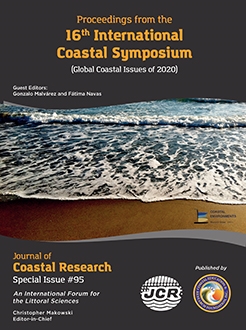Thomas, T.; Phillips, M.R., and Morgan, A.R., 2020. Maximising the use of disperate beach profile data. In: Malvárez, G. and Navas, F. (eds.), Global Coastal Issues of 2020. Journal of Coastal Research, Special Issue No. 95, pp. 621–625. Coconut Creek (Florida), ISSN 0749-0208.
In macrotidal environments, temporal variation in exposed spring tidal beach profiles is often used for assessment of morphological change, but variability in data acquisition curtails analysis to the shortest profile length. This paper describes a quantitative method maximising profile length that enables areas of concern reported by means of a traffic light system of red, amber and green. This refined model, originally introduced in 2018, Utilises, limits set statistically using confidence intervals (90%ile and 99%ile), calculated for either side of average beach levels derived from historic datasets. The visual output identifies relative levels of concern and exceedance of normal parameters would trigger higher levels of assessment defined by a predetermined management framework and the management response would vary depending on the coastal environment being assessed.





